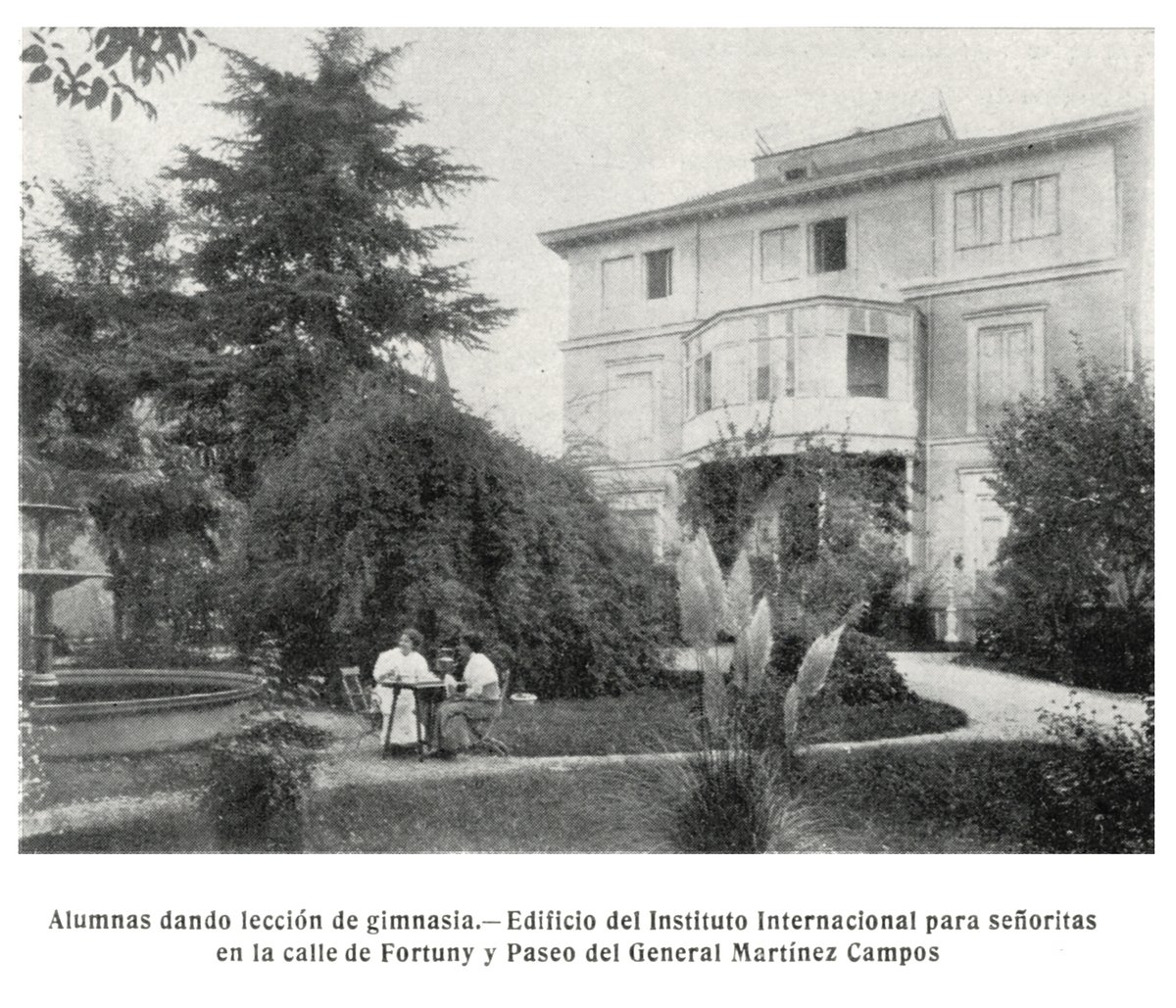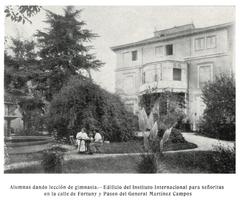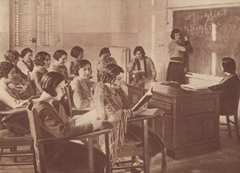
Residencia de Señoritas Madrid: Visiting Hours, Tickets, and Historical Guide
Date: 15/06/2025
Introduction
The Residencia de Señoritas in Madrid is a pioneering institution in the history of women’s education and social change in Spain. Founded in 1915 in the Chamberí district, it was the first official residence dedicated to university women, embodying the progressive ideals of early 20th-century Spain. Today, the site stands as a testament to advances in intellectual freedom, gender equality, and cultural innovation. This comprehensive guide provides all the essential information for visitors, including historical context, practical details, and tips for making the most of your visit to one of Madrid’s most significant historical landmarks (El Periódico de España; Academia.edu).
Table of Contents
- Introduction
- Origins and Mission
- Notable Figures and Intellectual Life
- Social and Political Significance
- The Civil War and Later Years
- Legacy and Current Status
- Architectural and Cultural Heritage
- Visiting Information
- Frequently Asked Questions (FAQ)
- Why Visit?
- Planning Your Visit
- Conclusion
- References
Origins and Mission
The Residencia de Señoritas was established in 1915 by the Junta para Ampliación de Estudios e Investigaciones Científicas (JAE), inspired by krausist and institucionist philosophies that promoted progressive education. Its mission was to provide women from diverse backgrounds access to higher education, cultural enrichment, and personal development, mirroring the ideals of the Institución Libre de Enseñanza (Academia.edu; Residencia de Estudiantes).
With strong support from the American International Institute for Girls in Spain, the Residencia offered not just accommodation, but also access to laboratories, a well-stocked library, and a robust program of lectures, concerts, and social activities. It became a model for progressive, holistic education for women.
Notable Figures and Intellectual Life
Under the directorship of María de Maeztu, the Residencia became an intellectual hub for Spain’s emerging generation of women leaders. Residents pursued degrees in fields such as Medicine, Science, Philosophy, and Law—areas then largely inaccessible to women.
Distinguished alumni and visitors included:
- Victoria Kent (lawyer and politician)
- María Zambrano (philosopher)
- Maruja Mallo (painter)
- Gabriela Mistral (Nobel laureate)
- Clara Campoamor (suffrage advocate)
- Victoria Ocampo (writer)
International figures such as Maria Montessori and Zenobia Camprubí also contributed to its vibrant intellectual life. The Residencia hosted influential lectures, cultural events, and was central to the founding of organizations like the Lyceum Club Femenino and the Asociación Universitaria Femenina, advancing women’s rights and professional opportunities (El Periódico de España; Residencia de Estudiantes).
Social and Political Significance
The Residencia played a transformative role in the modernization of Spanish society, especially during the Second Republic (1931–1936). It fostered an environment that championed equal intellectual and professional development for women, encouraging active participation in public life and laying the groundwork for future social reforms (Academia.edu).
The Civil War and Later Years
The outbreak of the Spanish Civil War in 1936 led to the repurposing of the Residencia as a hospital. Following the war, under the Franco regime, its progressive mission was suppressed, and it was rebranded as the Colegio Mayor Santa Teresa de Jesús, emphasizing conservative and religious values. Key figures like María de Maeztu went into exile, and many former residents faced political persecution (El Periódico de España).
Despite these challenges, the Residencia’s legacy endured through its extensive archival collections and the later restoration of its buildings as sites of cultural memory.
Legacy and Current Status
Today, the Residencia de Señoritas’ spirit is preserved by the Fundación José Ortega y Gasset-Gregorio Marañón, headquartered at Calle Fortuny in Chamberí. The original site and its archives are accessible through exhibitions, guided tours, and cultural programming, sustaining its vital role in gender equality and educational advancement (Ortega-Marañón Foundation).
Architectural and Cultural Heritage
The buildings of the Residencia de Señoritas showcase early 20th-century Madrid architecture, featuring Belle Époque and Modernist elements. Highlights include the main palace, landscaped gardens, and the Modernist Pavilion designed in 1933. Many original features are preserved, offering visitors a sense of the atmosphere that once nurtured intellectual exchange and cultural progress.
The site is closely linked to other icons of Madrid’s Silver Age, such as the Residencia de Estudiantes, which hosted luminaries like Albert Einstein (Vázquez Ramil, 2015).
Visiting Information
Location and Access
- Address: Calle Fortuny, 53/5, 28010 Madrid, Chamberí district
- Metro: Rubén Darío (Line 5), Gregorio Marañón (Lines 7 & 10)
- Bus: Several lines serve the area; check esMadrid for updates.
Visiting Hours
- Tuesday to Saturday: 10:00–18:00
- Sunday: 10:00–14:00
- Closed: Mondays and public holidays
(Verify current hours on the official website before visiting.)
Tickets and Booking
- General Admission: Usually free for exhibitions and public events.
- Guided Tours: May require advance booking or a small fee.
- Reservations: Recommended for tours, group visits, and during busy periods; check the contact page.
Accessibility
- The site is wheelchair accessible, with ramps and elevators available.
- Exhibition materials are mainly in Spanish, with some English translations and audio guides for major exhibitions.
- Contact the foundation in advance to arrange specific accessibility support.
Guided Tours
- Guided tours (primarily in Spanish) are available during special events or by prior arrangement.
- English-language tours may be available during major exhibitions; check the official site for details.
Facilities and Visitor Tips
- Restrooms: Accessible and modern.
- Café: Light refreshments available.
- Gift Shop: Books, postcards, and souvenirs related to the Residencia and women’s history.
- Photography: Permitted in most areas without flash or tripods; follow signage and staff instructions.
Nearby Attractions
- Residencia de Estudiantes
- Museo Sorolla
- Paseo de la Castellana
- National Museum of Natural Sciences
Combine your visit to the Residencia de Señoritas with these sites for a rich itinerary exploring Madrid’s intellectual and artistic heritage.
Frequently Asked Questions (FAQ)
Q: What are the visiting hours?
A: Tuesday to Saturday 10:00–18:00, Sunday 10:00–14:00, closed Mondays and public holidays.
Q: Is there an admission fee?
A: Admission is usually free, but guided tours or special events may require advance booking or a fee.
Q: Are guided tours available in English?
A: Tours are primarily in Spanish, with occasional English options during major exhibitions.
Q: Is the site wheelchair accessible?
A: Yes, ramps and elevators are available.
Q: Can I take photos inside the Residencia?
A: Yes, but flash and tripods are not allowed.
Q: Do I need to book tickets in advance?
A: For general admission, no. For guided tours and special events, advance booking is recommended.
Why Visit?
Visiting the Residencia de Señoritas offers a unique opportunity to explore the history of women’s education and social transformation in Spain. Walking through its historic halls, you connect with the pioneering women who helped shape modern Spain. The site’s architectural elegance, archival exhibitions, and ongoing cultural programming make it a must-visit for history enthusiasts, students, and travelers interested in Madrid’s heritage and the evolution of gender equality.
Planning Your Visit
- Check the official website for the latest visiting hours, events, and ticketing information.
- Consider timing your visit to coincide with special exhibitions or Madrid Otra Mirada (MOM) in October for expanded access and activities.
- Download the Audiala app for an enhanced audio guide and up-to-date cultural event notifications.
- Follow the Fundación Ortega-Marañón on social media to stay informed about exhibitions and special programs.
Conclusion
The Residencia de Señoritas stands as a living monument to the enduring pursuit of equality, intellectual freedom, and cultural progress in Spain. Whether you are exploring its architectural beauty, delving into its exhibitions, or tracing the stories of the women who lived and learned within its walls, your visit will be both enriching and inspiring. Plan ahead, immerse yourself in its legacy, and become part of the ongoing story of women’s empowerment in Madrid.
References
- Residencia de Señoritas Madrid: Visiting Hours, Tickets & Historical Significance, 2025, El Periódico de España (El Periódico de España)
- Visiting the Residencia de Señoritas: A Historical Landmark of Women’s Education in Madrid, 2025, Academia.edu (Academia.edu)
- Residencia de Señoritas Madrid: Visiting Hours, Tickets & Historical Guide, 2025, Fundación José Ortega y Gasset-Gregorio Marañón (Ortega-Marañón Foundation)
- Residencia de Estudiantes: Mujeres que hicieron historia, 2025, Residencia de Estudiantes (Residencia de Estudiantes)



































































































